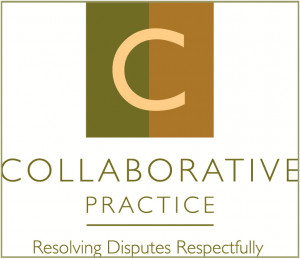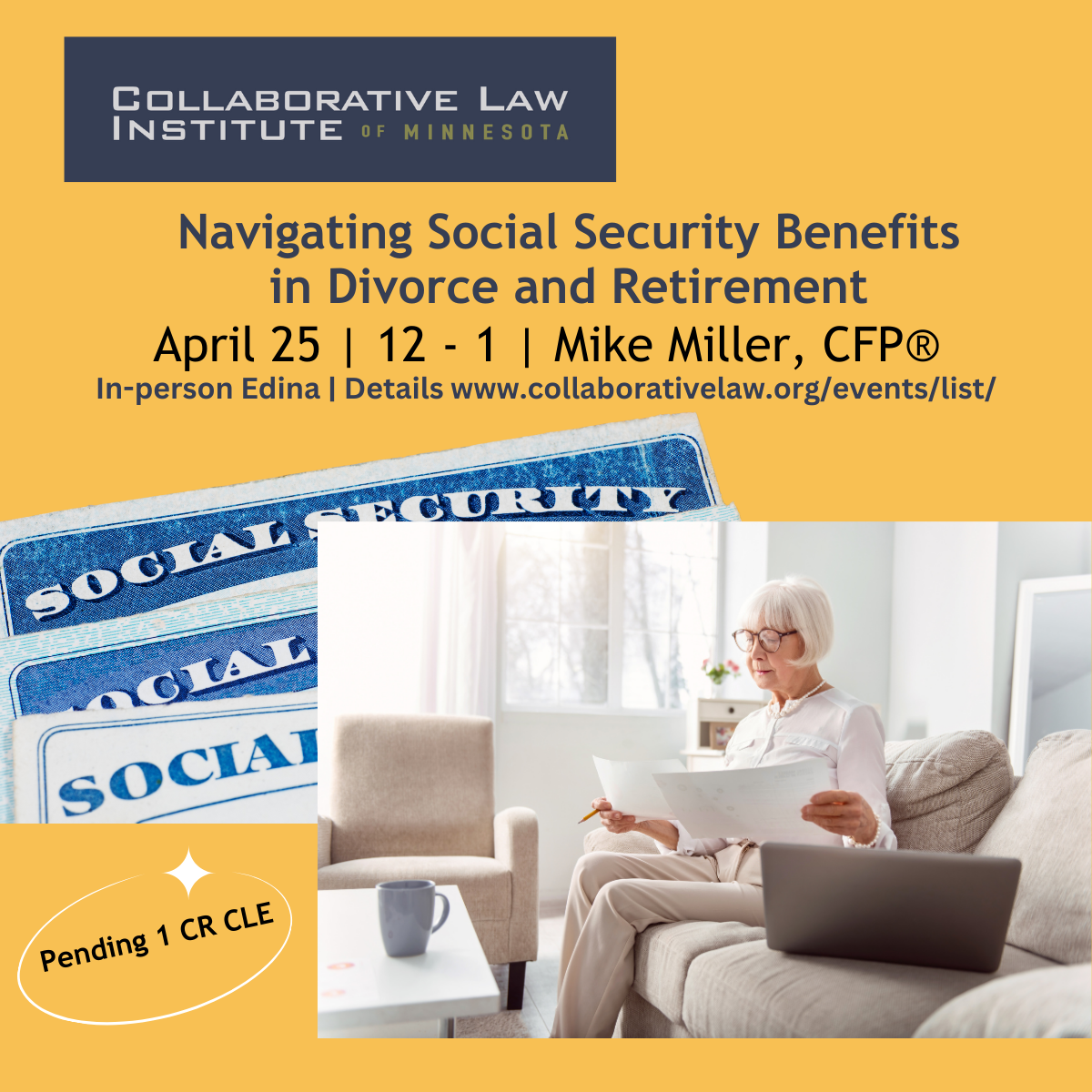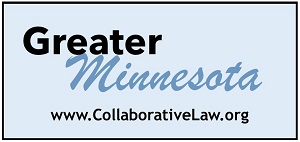Presentation Date: Thursday, April 25, 2024
Title: Navigating Social Security Benefits in Divorce and Retirement
Presenter: Mike Miller, CFP®
763.201.1390 | mike@integrashieldfinancial.com
Website: www.integrashieldfinancial.com
Description of Program:
This training will focus on helping attorneys improve their knowledge and understanding of Social Security and how divorce and retirement will impact their clients’ potential benefits.
We will briefly discuss the history of Social Security and its expansion in 1939. We will look at the value of Social Security and the application of Cost-of-Living Increases over time.
There will be a special focus on Social Security spousal benefits, divorced spouse benefits, survivor benefits and divorced survivor benefits including the requirements to qualify for these benefits. Though these benefits apply to all ages they are especially impactful in gray divorces.
Taxation of Social Security benefits will be discussed along with the unique provisions of the Windfall Elimination Provision and the Government Pension Offset.
We will briefly discuss Income Related Monthly Adjustment Amounts for Part B Medicare Premiums and exceptions for life changing events such as divorce.
Time:
11:30 AM Attendees arrive/Lunch served
11:50 AM Announcements and introductions
12:00 PM – 1:00 PM Presentation
Location: 3300 Edinborough Way, Edina, MN 55435, 1st Floor Training Room
Cost:
CLI Members and non-members: $25
CLI Student Members and CLI Emeritus Members: $10
Annual Partners: $0
Continuing Education:
1.0 credit PENDING MN CLE
Certificate of attendance for self-filing for MN Board of Psychology, LMFT, LICSW & ADR.
Cancellation: Refunds for registration will be processed if notice of cancellation is received by 4/18/24.
Who Should Attend: CLI Members, Family Law Professionals
Educational Level: Overview
Training Committee Chairs:
Louise Livesay-Al | louise@livesaylawoffice.com
Rebecca Randen | rebecca@rcglawoffice.com
For questions on registration contact: Sandy Beeson: cli@collaborativlaw.org
Since its inception in Minnesota 30 years ago, the Collaborative Divorce process has helped families in all 50 states and more than 25 countries find a healthier way to end their marriage without going to court. However, this respectful alternative to contested divorce has largely remained unavailable to families in greater Minnesota. The recent advent of virtual practice and Zoom meetings has changed this landscape and opened up new possibilities for the statewide availability of Collaborative Divorce.
The Collaborative Divorce process was created in 1990. Minnesota attorney Stu Webb, discouraged by the emotional and financial side effects of adversarial divorce, piloted a new approach in which attorneys would be involved for settlement purposes only. Because Collaborative divorce attorneys were disqualified from going to court, these attorneys needed to become effective and creative negotiators and problem solvers. The result was a process in which divorcing couples could design customized outcomes for their families and not go to court.
As the Collaborative Divorce concept grew throughout North America and the world, it evolved into a team process. By using specially trained neutral experts in child development, family systems and divorce-related finance in addition to their Collaborative attorneys, clients are able to bring this added expertise to their parenting and financial resolutions, and likely reduce the financial cost of their divorce. The process is tailored to the needs of the family using professionals based on the skills and expertise they need.
It has been an unfortunate reality for accessibility that specially trained Collaborative professionals are typically concentrated in metro areas, including in Minnesota. But with the social distancing required by the pandemic, almost all divorce professionals are working with and representing clients online, typically through Zoom meetings. This means that a couple’s distance from Collaboratively trained professionals is no longer an obstacle. Individuals in greater Minnesota, can now have access to a full Collaborative team without leaving their homes.
To learn if a Collaborative Divorce is right for you and your family, please visit the website of the Collaborative Law Institute of Minnesota at www.collaborativelaw.org. There you will find detailed information about the Collaborative process, as well as names and bios of Collaborative professionals who practice this family-friendly, problem-solving, and future-focused process. Collaboratively trained professionals will be happy to offer you free informational meetings via teleconferencing to help you make the decision about whether this process, and a particular attorney or neutral professional, feels right for your needs.
Collaborative Practice Highlights:
- The entire process is legally and ethically done outside of court
- The result of the process is customized to the particular needs of a divorcing couple and/or family
- Clients can build a team of Collaboratively trained attorneys, neutral financial experts, mediators and mental health professionals (coaches and child/family specialists) who focus on problem solving and dispute resolution
- Collaborative professionals can offer specialized ala carte services in specific areas of particular need for clients, e.g., financial plans, parenting plans, conflict resolution, preparation and review of legal documents, and more.
- Collaborative Law Institute of Minnesota (CLI) website: collaborativelaw.org
- Find a Professional: https://www.collaborativelaw.org/find-a-professional/
- CLI Blog: collaborativedivorceoptions.com
- CLI Mailing address: 4707 Highway 61 N, #217 | White Bear Lake, MN 55110
The Collaborative Law Institute of Minnesota and the North Dakota Collaborative Law Group are nonprofit organizations focused on transforming the way families divorce by helping them create customized solutions and stay out of court. For more information or to find a Collaborative professional near you visit www.collaborativelaw.org (CLI) or www.nddivorce.com (NDCLG)
About the Author: Shared by the Collaborative Law Institute of Minnesota
Shared by the Collaborative Law Institute of Minnesota
Public Education Committee
Frustrated with the world of politics today? Unless you are reading this from your hospital bed, having just awakened from a long coma, I am going to guess the answer is yes. Whether you are a Democrat or a Republican, it’s likely that you have about had it with all of the acrimony and with the arguments being made by “the other side”. Probably the one thing we can all agree on is that everyone on “the other side” is quite disagreeable, both in their opinions and their manner of expressing their views.
If you have bravely ventured out into the world of political discourse in an attempt to influence “the other side”, whether at a gathering of friends or family, or on some social media site, there is a pretty good chance you came away even more frustrated after the experience. Any naïve thoughts you may have had about the other person changing their mind likely hit a brick wall that, by the end of the exchange, had become, if anything, even stronger in its resistance. If “the other side” argued back at you there is a pretty good chance that your brick wall got fortified as well. You and “the other side” achieved the very opposite of what you both wanted to achieve, and you both were left in a state of frustration.
As a divorce lawyer, I am struck by how similar all of this is to how most couples behave when they are in conflict. I am hoping there is something about watching these political arguments that may create a true learning opportunity for these couples. The reality that I just described; the dynamic that most arguments lead to chaos, frustration, and a deepening of divisions is an important insight. And what better time to learn it than when you are going through a divorce.
Trust me, as someone who has “been through” numerous divorces, the maddening events that are playing out on the political stage, bear an amazing resemblance to conversations I have regularly observed in my office during the past three decades. Two people, seized with emotions, bent on getting another person to agree with them, stay awake at night thinking of great arguments to persuade their spouse that they are right, or worse, thinking of “good” attorneys who can do that for them.
If you are in the middle of it (either politics or divorce), you are likely so caught up in your frustration with “the other side” that you have little insight about what you are doing that is actually making your life worse. However, if you are able to stand back, if only for a moment, both with the political arena and arguments with divorcing couple, it is fairly easy to see that all we are doing is pouring gas on a raging fire. Once you come to that realization, you may find yourself wondering what the alternative might be. Our inner voice immediately retorts that “we can’t just give in”, thinking, from the standpoint of our ego, that fight or flight are the only true options. Is there a third option?
There is. It has different names, but the most common phrase that negotiators use is “interest-based bargaining.” I will skip that jargon and simply call this alternative “dialogue” for the moment. Dialogue, in the sense I am using it, is one of those ideas that is simple but not easy. It starts with the idea of letting go of arguments and changing minds and focusing instead on seeking common ground or at least a basis for common understanding. What I have observed, at least with divorcing couples, is that if we can reframe the discussion away from “arguments to change minds” and on to dialogues aimed at achieving common understanding, it is possible to achieve common goals. This type of dialogue is a central tenet of something called Collaborative Divorce. To learn more about Collaborative Divorce, go to www.collaborativelaw.org. In the meantime, watch what is happening on the political stage and see if there might be some valuable life lessons that will help us become a better nation, and better families.
About the Author Ron Ousky, JD, is a Collaborative Attorney and mediator who has dedicated his practice to making sure that families facing conflict understand their options. He believes that families facing divorce are in a unique situation to make a better life for their families and he is dedicated to helping them find the resources to build a better future. For more information about his practice go to www.ousky.com
Ron Ousky, JD, is a Collaborative Attorney and mediator who has dedicated his practice to making sure that families facing conflict understand their options. He believes that families facing divorce are in a unique situation to make a better life for their families and he is dedicated to helping them find the resources to build a better future. For more information about his practice go to www.ousky.com
 During the process of creating the parenting plan, the Neutral Child Specialist arranged for a meeting the parents both agreed to attend in which it could be determined, and possibly ruled out, whether dad did have any problems with substance abuse. This happened because of how the team of lawyers and professionals worked together thinking about the greater good of the family system. But at the meeting dad wasn’t ready to hear it, and again said he had things under control.
So, a parenting plan was created that gave daughter the opportunity to have time with her dad in smaller chunks of time, but have a mechanism in place to end the time if she ever felt at risk. Mom could also say no to time if she had a basis to say that dad was under the influence. They created details that both parents, and their child, felt comfortable with because they could focus on what was needed for the child to feel safe as well as the importance of the parent-child relationships.
After the divorce, about a year later, I received a note from her client. She said that dad was finally pursuing treatment with the two professionals the Neutral Child Specialist had arranged the meeting with during the work on the parenting plan. She said that dad finally hit bottom and was ready to begin his recovery.
When I look back on this case, I believe that a seed was planted and a relationship was started with people that dad could finally hold his hand out to for help when he was ready. And, because you can not force someone to make change before they are ready, a parenting plan was created that was responsive to the needs of the child. The dad was not dragged through the mud and vilified, and denied access to his child. Rather, a child responsive plan was put in place and now this family is on a better path.
The mom said in a note to me, “I really appreciate the entire collaborative team. The support through this most difficult time was immeasurably helpful. I found [your] and the team’s understanding, when dealing with a substance abuse spouse, extremely insightful. [The Neutral Child Specialist] was direct, yet kind in dealing with both [dad] and myself. The entire team had our daughter’s interests at the forefront. [Dad’s] attorney also was helpful in this aspect, aware of the pitfalls in dealing with an alcoholic….thank you…in helping me through this, supporting my goals and providing a positive environment.”
During the process of creating the parenting plan, the Neutral Child Specialist arranged for a meeting the parents both agreed to attend in which it could be determined, and possibly ruled out, whether dad did have any problems with substance abuse. This happened because of how the team of lawyers and professionals worked together thinking about the greater good of the family system. But at the meeting dad wasn’t ready to hear it, and again said he had things under control.
So, a parenting plan was created that gave daughter the opportunity to have time with her dad in smaller chunks of time, but have a mechanism in place to end the time if she ever felt at risk. Mom could also say no to time if she had a basis to say that dad was under the influence. They created details that both parents, and their child, felt comfortable with because they could focus on what was needed for the child to feel safe as well as the importance of the parent-child relationships.
After the divorce, about a year later, I received a note from her client. She said that dad was finally pursuing treatment with the two professionals the Neutral Child Specialist had arranged the meeting with during the work on the parenting plan. She said that dad finally hit bottom and was ready to begin his recovery.
When I look back on this case, I believe that a seed was planted and a relationship was started with people that dad could finally hold his hand out to for help when he was ready. And, because you can not force someone to make change before they are ready, a parenting plan was created that was responsive to the needs of the child. The dad was not dragged through the mud and vilified, and denied access to his child. Rather, a child responsive plan was put in place and now this family is on a better path.
The mom said in a note to me, “I really appreciate the entire collaborative team. The support through this most difficult time was immeasurably helpful. I found [your] and the team’s understanding, when dealing with a substance abuse spouse, extremely insightful. [The Neutral Child Specialist] was direct, yet kind in dealing with both [dad] and myself. The entire team had our daughter’s interests at the forefront. [Dad’s] attorney also was helpful in this aspect, aware of the pitfalls in dealing with an alcoholic….thank you…in helping me through this, supporting my goals and providing a positive environment.”
 The second definition provides a visual for what many think a divorce “looks like.” While the end of a marriage is emotionally tumultuous and devastating, the actual legal process of uncoupling does not have to be. But, it is critical that you choose a process that promotes healing. The Collaborative Process does just that.
Collaboration is a holistic approach to divorce. It can be utilized by couples who are ending either a marriage or significant relationship, or who have a child or children together. Although some people question whether it is an appropriate process when domestic abuse or mental health/chemical dependency issues are present, many others think it can (and should) at least be attempted. If you don’t want to be another “divorce horror story,” the Collaborative Process will likely be a great fit.
Collaboration focuses on the future (i.e., the relationship of co-parenting in two homes) rather than the past (i.e. the vilification of one spouse); is a win-win for both partners (rather than a court-imposed win-lose); and emphasizes the well-being of the entire family. You don’t air your dirty laundry in court, and you aren’t (literally) judged. In fact, you never set foot in a courtroom. The negotiation model is interest-based/win-win, rather than positional/win-lose. You pay attorneys to help you solve problems, not argue and keep you stuck in the past. Every family is unique, so every family deserves a unique solution. And if you have young children, please keep in mind they need you present and available. You can’t be present when you are fighting the other parent in court. In Part 3, we will discuss the various professionals in the Collaborative Process and how their expertise can help you avoid the divortex.
The second definition provides a visual for what many think a divorce “looks like.” While the end of a marriage is emotionally tumultuous and devastating, the actual legal process of uncoupling does not have to be. But, it is critical that you choose a process that promotes healing. The Collaborative Process does just that.
Collaboration is a holistic approach to divorce. It can be utilized by couples who are ending either a marriage or significant relationship, or who have a child or children together. Although some people question whether it is an appropriate process when domestic abuse or mental health/chemical dependency issues are present, many others think it can (and should) at least be attempted. If you don’t want to be another “divorce horror story,” the Collaborative Process will likely be a great fit.
Collaboration focuses on the future (i.e., the relationship of co-parenting in two homes) rather than the past (i.e. the vilification of one spouse); is a win-win for both partners (rather than a court-imposed win-lose); and emphasizes the well-being of the entire family. You don’t air your dirty laundry in court, and you aren’t (literally) judged. In fact, you never set foot in a courtroom. The negotiation model is interest-based/win-win, rather than positional/win-lose. You pay attorneys to help you solve problems, not argue and keep you stuck in the past. Every family is unique, so every family deserves a unique solution. And if you have young children, please keep in mind they need you present and available. You can’t be present when you are fighting the other parent in court. In Part 3, we will discuss the various professionals in the Collaborative Process and how their expertise can help you avoid the divortex.
 Rather than utter that renowned phrase to my son, my collaboratively-trained lawyer brain went into “better-get-more-information” mode. The conversation went like this:
Me: How did that make you feel when he said that?
Son: Sad.
Me: Mmmmm….I can see that…
Son: And angry…
Me: Definitely! (Pause). So, what happened next?
Son: (without missing a beat) I grabbed the ball out of his hands, dribbled it down the court, and made a basket.
Me: (Stunned!) Wow! That is AMAZING! (Beaming with pride…that’s my boy!)
So, my son “shows up” this kid by making a basket, yet he was still upset (hours?) later and recalls the name-calling rather than his awesome basket?! This certainly illustrates words have a HUGE impact on others, whether we realize it or not. It doesn’t have to be name-calling, either. It can be just the language we use and the way we say it. The tone in our voice can turn an otherwise innocuous comment into a heated argument. So…STOP. Take a DEEP breath (and maybe throw a stick at some THING). THINK before you speak, and CHOOSE your words carefully. Then go shoot some hoops.
Rather than utter that renowned phrase to my son, my collaboratively-trained lawyer brain went into “better-get-more-information” mode. The conversation went like this:
Me: How did that make you feel when he said that?
Son: Sad.
Me: Mmmmm….I can see that…
Son: And angry…
Me: Definitely! (Pause). So, what happened next?
Son: (without missing a beat) I grabbed the ball out of his hands, dribbled it down the court, and made a basket.
Me: (Stunned!) Wow! That is AMAZING! (Beaming with pride…that’s my boy!)
So, my son “shows up” this kid by making a basket, yet he was still upset (hours?) later and recalls the name-calling rather than his awesome basket?! This certainly illustrates words have a HUGE impact on others, whether we realize it or not. It doesn’t have to be name-calling, either. It can be just the language we use and the way we say it. The tone in our voice can turn an otherwise innocuous comment into a heated argument. So…STOP. Take a DEEP breath (and maybe throw a stick at some THING). THINK before you speak, and CHOOSE your words carefully. Then go shoot some hoops.
 A collaborative law colleague recently wrote a lovely piece in the Boston Globe describing his reasons for leaving his litigation practice behind and representing clients only in alternative dispute resolution processes. His article resonated greatly with me. I too left behind a litigation practice to enter the world of peacemaking. While not an easy choice at the time, I look back six years later and realize that these years have been the most fulfilling of my career. I have not stepped foot in a courtroom in almost six years.
I am thankful for many things in my current “out of court” career, but here are just a few:
A collaborative law colleague recently wrote a lovely piece in the Boston Globe describing his reasons for leaving his litigation practice behind and representing clients only in alternative dispute resolution processes. His article resonated greatly with me. I too left behind a litigation practice to enter the world of peacemaking. While not an easy choice at the time, I look back six years later and realize that these years have been the most fulfilling of my career. I have not stepped foot in a courtroom in almost six years.
I am thankful for many things in my current “out of court” career, but here are just a few:
- I spend my days working with clients on resolutions that meet their big picture goals.
- My conversations and negotiations are fruitful, honest and genuine. The teams I work with and clients who choose me are seeking this type of interest-based negotiation without gamesmanship or posturing.
- My colleagues are professionals with passion and dedication to help people through transitions in their marriage – many are my friends, including attorneys who are on the “other side” representing my client’s spouse.
- I can be creative in tailoring outcomes to meet my clients goals.
- We can tailor my work to each client and what they need and want out of the process.
- I am a peacemaker who is at peace.
 In the early days of separation and divorce you may find the idea of growing from your divorce difficult to believe. You may be in a state of depression or denial wondering how your life will carry on, much less that you will grow from this life change. It may be difficult to find the silver lining, yet the simple truth is that you can (and will) grow from this. You may or may not have had much of a choice in whether or not you are getting a divorce, but you DO have a choice whether to grow up or grow down through this process.
In a bad or difficult marriage it is easy to see how a person might grow from getting a divorce, but all divorces bring the opportunity for growth. Your divorce will likely change the way you view the world. Your life may be functioning completely different than before. Maybe you are having to look for a new career or add a part time job to make ends meet, or maybe you’ve been out of the workforce for years and your divorce is forcing you back in. Maybe you’ve had to move to an apartment or back in with your parents or a friend. Maybe your kids are at a new school as a result of your divorce. Maybe your entire social circle has now changed. It’s how you view these changes and react to your new normal, that promotes growth.
Growth from your divorce can appear in a number of ways. Emotionally, spiritually, physically, etc. Even something as simple as learning a new skill that your spouse had always managed like trimming the shrubs, or online bill pay. Spiritually your faith might deepen or may struggle as you get through some trying times. Emotional growth may take a bit longer. There may be some dark and difficult days before you start to grow emotionally, but slowly it will happen. Your priorities will change and grow. If you have shared custody with your children you will likely start to value your time together all that much more. Some things that were priorities during your marriage may no longer hold a significance to you.
Growth after divorce becomes a way to cope. Growth after divorce becomes a way to survive. Growth after divorce becomes empowerment. Growth after divorce becomes a new, better you.
In the early days of separation and divorce you may find the idea of growing from your divorce difficult to believe. You may be in a state of depression or denial wondering how your life will carry on, much less that you will grow from this life change. It may be difficult to find the silver lining, yet the simple truth is that you can (and will) grow from this. You may or may not have had much of a choice in whether or not you are getting a divorce, but you DO have a choice whether to grow up or grow down through this process.
In a bad or difficult marriage it is easy to see how a person might grow from getting a divorce, but all divorces bring the opportunity for growth. Your divorce will likely change the way you view the world. Your life may be functioning completely different than before. Maybe you are having to look for a new career or add a part time job to make ends meet, or maybe you’ve been out of the workforce for years and your divorce is forcing you back in. Maybe you’ve had to move to an apartment or back in with your parents or a friend. Maybe your kids are at a new school as a result of your divorce. Maybe your entire social circle has now changed. It’s how you view these changes and react to your new normal, that promotes growth.
Growth from your divorce can appear in a number of ways. Emotionally, spiritually, physically, etc. Even something as simple as learning a new skill that your spouse had always managed like trimming the shrubs, or online bill pay. Spiritually your faith might deepen or may struggle as you get through some trying times. Emotional growth may take a bit longer. There may be some dark and difficult days before you start to grow emotionally, but slowly it will happen. Your priorities will change and grow. If you have shared custody with your children you will likely start to value your time together all that much more. Some things that were priorities during your marriage may no longer hold a significance to you.
Growth after divorce becomes a way to cope. Growth after divorce becomes a way to survive. Growth after divorce becomes empowerment. Growth after divorce becomes a new, better you.
 When getting divorced, it is important to have a support network. Having a sounding board and friends to talk through things with can help you evaluate options. They can remind you that you are not alone. Acquaintances who have gone through divorce themselves or who have certain expertise (like financial or real estate), may be able to help you with some of the decisions. Everyone needs someone to talk to.
However, sometimes well-intentioned people can cause more harm during the divorce process than good. Everyone seems to have a neighbor that somehow obtained a “better deal” than you did. They either received more in settlement or support than you are considering or they paid less than you. This “Greek Chorus” phenomenon can slow down progress and make a collaborative process more difficult than it needs to be.
When reaching out to others for support during divorce, keep the following things in mind:
When getting divorced, it is important to have a support network. Having a sounding board and friends to talk through things with can help you evaluate options. They can remind you that you are not alone. Acquaintances who have gone through divorce themselves or who have certain expertise (like financial or real estate), may be able to help you with some of the decisions. Everyone needs someone to talk to.
However, sometimes well-intentioned people can cause more harm during the divorce process than good. Everyone seems to have a neighbor that somehow obtained a “better deal” than you did. They either received more in settlement or support than you are considering or they paid less than you. This “Greek Chorus” phenomenon can slow down progress and make a collaborative process more difficult than it needs to be.
When reaching out to others for support during divorce, keep the following things in mind:
- Remember that you live with your resolutions. If something feels right to you, it might be best to not let your friends talk you out of it.
- You can always ask your support network to just listen.
- Figure out how you feel after talking through things with certain friends – if it doesn’t make you feel better or more positive about resolutions, they may not be the best support.
- If you ask for advice, be very specific about what you are asking for and let your support know that you may not take their advice, you are just gathering information.
- Be careful if you seek advice on one piece of the settlement without considering all elements.
- You can always use your collaborative attorney as your sounding board instead of peers. Your friends and family can support you in other ways.
 As a collaborative attorney, I am often asked “what would a court do?” Although parties in a collaborative divorce are not asking the court to make decisions in their case, what the law is and how a court may view an issue is important. It is part of the information that a client needs to understand to truly make a decision in their own best interest.
I recently attended an education series with local judges to gain an understanding of the current state of the law. In the second part of this 2 part series, I outline some of the factors a court may consider in making litigated decisions.
On property division and cash flow, here are some of the considerations:
As a collaborative attorney, I am often asked “what would a court do?” Although parties in a collaborative divorce are not asking the court to make decisions in their case, what the law is and how a court may view an issue is important. It is part of the information that a client needs to understand to truly make a decision in their own best interest.
I recently attended an education series with local judges to gain an understanding of the current state of the law. In the second part of this 2 part series, I outline some of the factors a court may consider in making litigated decisions.
On property division and cash flow, here are some of the considerations:
- When dividing assets and liabilities, the courts often begin with an accounting and confirmation of all real estate, accounts, retirement assets, investments, stock options, inheritances, gifts, debts, personal property, vehicles, and all other possessions.
- The courts have to differentiate between marital property that was created or acquired during the marriage and non-marital property that should stay with one party. Non- marital property may include assets from before marriage, gifts or inheritances, and student loans.
- Non-marital property stays with the receiving party. Marital property is divided equitably. This is often interpreted as equally, although there are some exceptions if the outcome is deemed unfair.
- Division of property is a separate question from cash flow (child support and spousal maintenance).
- Child support in court is often calculated with the guidelines based on percentage of overnights with each parent and incomes. Then medical expenses and extra curricular activities are shared by percentage of income.
- Spousal maintenance or alimony is a discretionary area of the law. It is based on the needs of the recipient and the ability of the other spouse to provide support.
- Court requires an analysis of budgets and income or potential income of both parties. It can be difficult to address income if a party has not or is not working.
- Some of the factors for determining support include: length of the marriage, education and age of the spouses with regard to work ability, work history, parenting needs of children, and reasonableness of expenses.
- Because spousal maintenance is one of the most discretionary areas of family law, it is difficult to find consistent outcomes in the court as every case is decided based on the individual facts (and judge).




